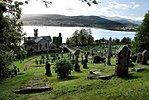Lazaretto Point War Memorial
1922 sculptures1923 establishments in ScotlandBritish military memorials and cemeteriesBuildings and structures in Argyll and ButeCenotaphs in the United Kingdom ... and 6 more
Monuments and memorials in ScotlandOutdoor sculptures in ScotlandScottish building and structure stubsStone sculptures in ScotlandWorld War II memorials in ScotlandWorld War I memorials in Scotland

Erected in 1922, the Lazaretto Point War Memorial (known colloquially as the Lazaretto Memorial) is located in the Scottish village of Ardnadam in Argyll and Bute. It stands, at the apex of sharp bend in the A815, around the midpoint of the southern shores of the Holy Loch. It was designed by Boston, Menzies & Morton, of Greenock, and unveiled on 14 May 1922. It commemorates the local soldiers who died during service in World War I and World War II.Mrs John Brown, of nearby Sandbank, performed the unveiling. Five of her sons served in the conflicts, one of whom was killed in action. Reverend A. MacDonald M.A., also of Sandbank, officiated at the ceremony.
Excerpt from the Wikipedia article Lazaretto Point War Memorial (License: CC BY-SA 3.0, Authors, Images).Lazaretto Point War Memorial
Shore Road,
Geographical coordinates (GPS) Address Nearby Places Show on map
Geographical coordinates (GPS)
| Latitude | Longitude |
|---|---|
| N 55.9818274 ° | E -4.93102446 ° |
Address
Sandbank War Memorial
Shore Road
PA23 8QD
Scotland, United Kingdom
Open on Google Maps









